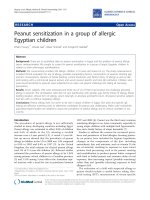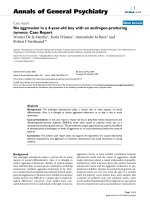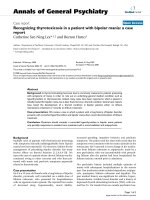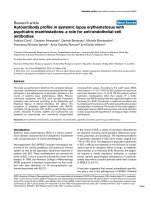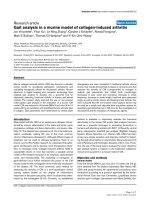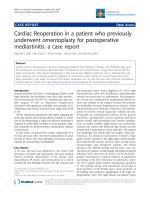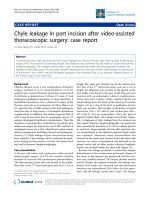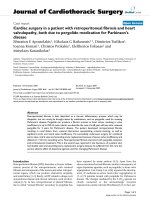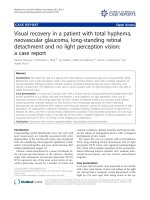Báo cáo y học: "No aggression in a 4-year-old boy with an androgen-producing tumour: Case Repor" pdf
Bạn đang xem bản rút gọn của tài liệu. Xem và tải ngay bản đầy đủ của tài liệu tại đây (276.39 KB, 4 trang )
BioMed Central
Page 1 of 4
(page number not for citation purposes)
Annals of General Psychiatry
Open Access
Case report
No aggression in a 4-year-old boy with an androgen-producing
tumour: Case Report
Wouter De la Marche
1
, Karin Prinsen
1
, Annemieke M Boot
2
and
Robert F Ferdinand*
1
Address:
1
Department of Child and Adolescent Psychiatry, Erasmus Medical Center Rotterdam/Sophia Children's Hospital, The Netherlands and
2
Department of Paediatrics, Erasmus Medical Center Rotterdam/Sophia Children's Hospital, The Netherlands
Email: Wouter De la Marche - ; Karin Prinsen - ; Annemieke M Boot - ;
Robert F Ferdinand* -
* Corresponding author
androgenstestosteroneaggressionchildren
Abstract
Background: The androgen testosterone plays a critical role in many aspects of sexual
differentiation. Also, it is thought to induce aggressive behaviours or to play a role in social
dominance.
Case presentation: In this case report a 4-year-old boy is described whose testosterone and
dehydroepiandrosterone sulphate (DHEA-S) levels were raised to pubertal levels due to a
testosterone producing testis tumour. This provided the unique opportunity to examine the effects
of elevated levels of androgens on levels of aggression or on social dominance before the onset of
puberty.
Conclusion: The present case report does not support the hypothesis of a causal relationship
between testosterone and aggression or between testosterone and social dominance in young
children.
Background
The androgen testosterone plays a critical role in many
aspects of sexual differentiation. Also, it is thought to
induce aggressive behaviours. Results of animal studies
have indicated that, in most species, androgens, including
testosterone, facilitate aggressive behaviour [1-5]. How-
ever, studies that investigated associations between andro-
gens and aggression in humans have yielded inconclusive
results and are very difficult to compare due to methodo-
logical differences. Moreover, most studies have com-
pared hormone levels in individuals with high versus low
aggression levels, or have yielded correlations between
testosterone levels and the extent of aggression, which
makes inferences about a causal relationship impossible.
Furthermore, little is known about the relation between
testosterone levels and the aggressive behaviour in pre-
adolescent children. Because in normal development, tes-
tosterone levels are very low from the age of 6 months
until pre-puberty, most studies have used samples that
consisted of pubertal and post pubertal males. More
recent studies hypothesised there might be an association
between testosterone and social dominance instead [6-8].
Published: 03 October 2005
Annals of General Psychiatry 2005, 4:17 doi:10.1186/1744-859X-4-17
Received: 25 May 2005
Accepted: 03 October 2005
This article is available from: />© 2005 De la Marche et al; licensee BioMed Central Ltd.
This is an Open Access article distributed under the terms of the Creative Commons Attribution License ( />),
which permits unrestricted use, distribution, and reproduction in any medium, provided the original work is properly cited.
Annals of General Psychiatry 2005, 4:17 />Page 2 of 4
(page number not for citation purposes)
Because ethically it is impossible to set up experiments to
respond to the question of causal relationships, we should
rely on natural experiments.
In the present report we describe the case of a 4-year-old
boy whose testosterone and dehydroepiandrosterone sul-
phate (DHEA-S) levels were raised to pubertal levels due
to pseudo pubertas praecox based on a testosterone pro-
ducing testis tumour. This provided the unique opportu-
nity to examine the effects of elevated levels of
testosterone and DHEA-S on levels of aggression in a
young child. The fact that the androgen levels in this boy
were raised to about 30 times the normal level for his age
makes this case a unique natural experiment.
Case presentation
In June 2002, a boy aged 4 years and three months, was
referred to the outpatient clinic of oncology of the Eras-
mus Medical Center of Rotterdam. One year before, penis
growth had started to accelerate rapidly and 2 months
prior to admission, his height had started to increase tre-
mendously, pubic hair had started to grow, his voice had
started breaking, and sweat production had increased.
Furthermore, he often had erections during the day, got
interested in older girls, and started reading magazines
that contained pictures of naked women.
At clinical examination, his length was 120 cm (more
than 2.5 SD above average) and he weighed 24.6 kg
(weight/height ratio +1 SD). His sexual development had
reached Tanner stages P3, G3 [9], with no underarm hair
growth. Examination of his genitals showed a left testis of
2 ml and a right testis of 6 ml, firm and painless. Further
clinical examination was negative, except for glue ears. X-
rays of his hand showed that his skeletal age was 5 years
ahead of his calendar age. His testosterone level (10.6
nmol/l) was raised to a pubertal level, as well as his
DHEA-S level (1.30 µmol/l). Tumour markers carcino-
embryonal antigen (CEA), alpha-fetoprotein, and beta
human choriogonadotropin (β-HCG) were negative.
Ultrasound of the testes showed a testicular tumour. Nei-
ther abdominal ultrasound nor abdominal CT or full
bonescan (209MBq TC99M) showed signs of metastases.
Pseudo pubertas praecox based on a testicular tumour was
diagnosed. After unilateral orchidectomy, pathological
examination showed a Leydig Cell Tumour. One week
after orchidectomy, hormone levels had normalized (tes-
tosterone < 0.10 nmol/l, DHEA-S < 0.20 µmol/l), he
stopped having erections, and sweat production
decreased, as did his sexual interest. His mother reported
he had become more of a child again.
Because of anxiety, some behavioural problems, and
delayed speech development, the boy was referred to our
outpatient unit for child and adolescent psychiatry. At
psychiatric examination, January 2003, we saw a boy who
was anxious and withdrawn, had problems in social inter-
action, and a delayed speech development. Parents
reported he had always been very quiet, however, since
the beginning of 2002 he had started withdrawing himself
more and more from social interactions, both at home
and in school. To obtain standardized ratings of psycho-
pathology, both parents, as well as the schoolteacher,
were asked to fill out the Child Behaviour Checklist for
ages 1 1/2–5 (CBCL 1 1/2–5) and the Caregiver-Teacher
Report Form for ages 1 1/2–5 (C-TRF 1 1/2–5) [10]. The
mother and the father scored the patient in the clinical
range of the Withdrawn Behaviour, Anxious/Depressed
Behaviour, and Somatic Complaint scales, but not on the
Emotionally Reactive Behaviour, Sleep Problems, Atten-
tion Problems, and Aggressive Behaviour scales. The clin-
ical cut-off corresponds with the 98
th
percentile score in a
general population sample [10]. Although the school-
teacher described the boy as quiet and withdrawn, and
mentioned delayed speech development, C-TRF syn-
drome scores were not in the clinical range. No symptoms
of externalizing behaviour (aggression, hyperactive
behaviour or attention problems) were reported by the
parents or the teacher, nor seen during psychiatric assess-
ment. Further psychological testing showed that the boy's
intellectual functioning was below average (Wechsler Pre-
school and Primary Scale of Intelligence – Revised [11]:
Total IQ = 84; Verbal IQ = 82; Performance IQ = 92).
DSM-IV [12] chronic adjustment disorder with anxiety
was diagnosed.
Discussion
In this case study, we report about a 4-year-old boy with
an androgen producing testis tumour, in whom testoster-
one and DHEA-S levels rose to pubertal concentrations. It
is a normal biological reaction that, when the testes begin
to secrete androgens, sex drive and the motivation to seek
sexual contact become stronger and are overtly expressed
more and more [13,14]. It is remarkable however that,
parallel to the sexual development and increased sexual
drive, the boy we describe did not show increased levels of
aggression. On the contrary, the boy was described as anx-
ious and withdrawn.
The fact that the raised androgen levels are not accompa-
nied by aggression is not consistent with the results of pre-
vious studies that found an association between androgen
levels (testosterone and/or DHEA-S) and aggression [15-
18]. For instance, in a study in which 8- to 12-year-old
children (n = 15) with a Conduct Disorder were compared
to normal controls (n = 25), van Goozen et al. [18] found
significant correlations between DHEA-S levels and scores
on the CBCL and TRF subscales Aggressive Behaviour (r =
.46 and .48 respectively) and Delinquent Behaviour (r =
Annals of General Psychiatry 2005, 4:17 />Page 3 of 4
(page number not for citation purposes)
.33 and .39 respectively). A possible explanation for the
inconsistency between these studies and our 4-year-old
boy can be that raised androgen levels are not the cause
but a consequence of aggression.
Tremblay et al. concluded that testosterone at age 12
makes an independent contribution to explain social
dominance at age 13. They consider as well that the high
levels of testosterone could be as well the product as much
as the cause of social dominance. They further suggest that
the testosterone-dominance link should be present from
infancy onwards, if it exists [8]. The boy we described in
this case report had primarily high levels of testosterone,
that didn't lead to social dominance. In contrast, he was
anxious and withdrawn, which might have several causes.
First, even without the occurrence of a hormone-produc-
ing tumour, the boy might have been at risk for these
symptoms; family history was negative for anxiety but
mother had suffered from a depressive episode before.
Second, due to his extreme height, parents and other
adults or children may have made age-inappropriate
demands, which may have caused anxiety. Third, extreme
changes in hormone levels may have directly resulted in
withdrawal from social contacts. Sánchez-Martín et al.
[19] examined 28 boys and 20 girls with a mean age of 4
years by videotaping them every morning during free play
in the classroom during 4 months. They found that higher
levels of testosterone were associated with decreased
direct interaction with peers. The last explanation is in
contradiction with the social dominance hypothesis.
Most of the studies that showed a relation between andro-
gens and aggression were carried out with adults or ado-
lescents. Previous studies with young children in
prepuberty did not find much evidence for this relation
[15,20]. For instance, Constantino et al. [20] studied 18
very aggressive 4- to 10-year-olds. They did not find an
association between serum testosterone levels and the
scores on the Aggressive Behaviour scale of the CBCL. To
explain this lack of association, it can be argued that con-
centrations of androgens in young children are too low to
find effects of testosterone on aggression anyway. In the
boy in the present case report, however, serum testoster-
one levels were about 30 times the regular levels for his
age and signs of aggression were still not found (figure 1).
Conclusion
Although we know that one case cannot proof nor refute
any hypothesis about causal relationships or associations
between hormone levels and aggression or social domi-
nance, natural experiments like this can help with formu-
lating hypotheses for further research.
Competing interests
The author(s) declare that they have no competing
interests.
Authors' contributions
Wouter De la Marche, MD: Mane author of the article.
Karin Prinsen, MSc, has made substantial contributions in
writing the background and the psychiatric examination,
as well as in revising the discussion.
Annemieke M. Boot, MD, PhD has carried out the somatic
examination and supervised the technical examinations.
She helped us formulating this part of the article. Robert
F. Ferdinand, MD, PhD has been involved in revising this
article critically for important intellectual content and has
given final approval of this version of the article to be
published.
Age at the time of the picture: 4 yearsFigure 1
Age at the time of the picture: 4 years
Publish with BioMed Central and every
scientist can read your work free of charge
"BioMed Central will be the most significant development for
disseminating the results of biomedical research in our lifetime."
Sir Paul Nurse, Cancer Research UK
Your research papers will be:
available free of charge to the entire biomedical community
peer reviewed and published immediately upon acceptance
cited in PubMed and archived on PubMed Central
yours — you keep the copyright
Submit your manuscript here:
/>BioMedcentral
Annals of General Psychiatry 2005, 4:17 />Page 4 of 4
(page number not for citation purposes)
Acknowledgements
Written consent was obtained from the patient's parents for publication of
this case report.
References
1. Bouissou M: Androgens, aggressive behaviour and social rela-
tionships in higher mammals. Horm Res 1983, 18:43-61.
2. Brain PF: Effects of the hormones of the pituitary-gonadal axis
on behavior. In Chemical Influence on Behavior Edited by: Brown K,
Cooper SJ. New York: Academic Press; 1979:255-329.
3. Bronson FH, Desjardins C: Steroid hormones and aggressive
behavior in mammals. In The Physiology of Aggression and Defeat
Edited by: Eleftheriou BE, Scott JP. New York: Plenum; 1971:43-63.
4. Moyer KE: The Psychobiology of Aggression New York: Harper & Row;
1976.
5. Rose RM, Bernstein IS, Holaday JW: Plasma testosterone domi-
nance rank, and aggressive behavior in a group of male rhe-
sus monkeys. Nature 1971, 231:366-368.
6. Rowe R, Maughan B, Worthman CM, Costello EJ, Angold A: Testo-
sterone, Antisocial Behavior, and Social Dominance in Boys:
Pubertal Development and Biosocial Interaction. Biol
Psychiatry 2004, 55:546-552.
7. Schaal B, Tremblay TE, Soussignan R, Susman EJ: Male Testoster-
one Linked to High Social Dominance but Low Physical
Aggression in Early Adolescence. J Am Acad Child Adolesc
Psychiatry 1996, 35:1322-1330.
8. Tremblay RE, Schaal B, Boulerice B, Arsenault L, Soussigna RG,
Paquette D, Laurent D: Testosterone, Physical Aggression,
Dominance, Physical Development in Early Adolescence. Int
J Behav Dev 1998, 22:753-777.
9. Tanner JM: Growth at Adolescence Oxford: Blackwell; 1962.
10. Achenbach TM, Rescorla LA: Manual for ASEBA Preschool Forms & Pro-
files Burlington VT: University of Vermont, Research Center for Chil-
dren, Youth, & Families; 2000.
11. Wechsler D: Wechsler Preschool and Primary Scale of Intelligence –
Revised (WPPSI-R) San Antonio: Psychological Corporation; 1989.
12. American Psychiatric Association: Diagnostic and Statistical Manual of
Mental Disorders, (DSM-IV) 4th edition. Washington DC: American
Psychiatric Association; 1994.
13. Albert DJ, Walsh ML, Jonik RH: Aggression in humans: what is its
biological foundation? Neurosci Biobehav Rev 1993, 17:405-425.
14. Christiansen K: Behavioural effects of androgen in men and
women. J Endocrinol 2001, 170:39-48.
15. Finkelstein JW, Susman EJ, Chinchilli VM, Kunselman SJ, D'Arcangelo
MR, Schwab J, Demers LM, Liben LS, Lookingbill G, Kulin HE: Estro-
gen or testosterone increases self-reported aggressive
behaviors in hypogonadal adolescents. J Clin Endocrinol Metab
1997, 82:2433-2438.
16. Scerbo AS, Kolko DJ: Salivary testosterone and cortisol in dis-
ruptive children: relationship to aggressive, hyperactive, and
internalizing behaviors. J Am Acad Child Adolesc Psychiatry 1994,
33:1174-1184.
17. van Goozen SHM, Matthys W, Cohen-Kettenis PT, Thijssen JHH, van
Engeland H: Adrenal androgens and aggression in conduct dis-
order prepubertal boys and normal controls. Biol Psychiatry
1998, 43:156-158.
18. van Goozen SHM, van den Ban E, Matthys W, Cohen-Kettenis PT,
Thijssen JHH, van Engeland H: Increased adrenal androgen func-
tioning in children with oppositional defiant disorder: a com-
parison with psychiatric and normal controls. J Am Acad Child
Adolesc Psychiatry 2000, 39:1446-1451.
19. Sánchez-Martín JR, Fano E, Ahedo L, Cardas J, Brain PF, Azpíroz A:
Relating testosterone levels and free play social behavior in
male and female preschool children. Psychoneuroendocrenology
2000, 25:773-783.
20. Constantino JN, Grosz D, Saenger P, Chandler DW, Nandi R, Earls
FJ: Testosterone and aggression in children. J Am Acad Child
Adolesc Psychiatry 1993, 32:1217-1222.
